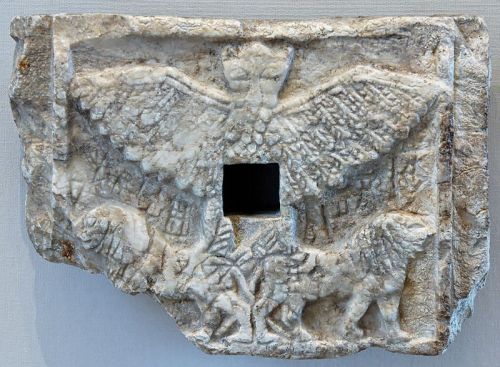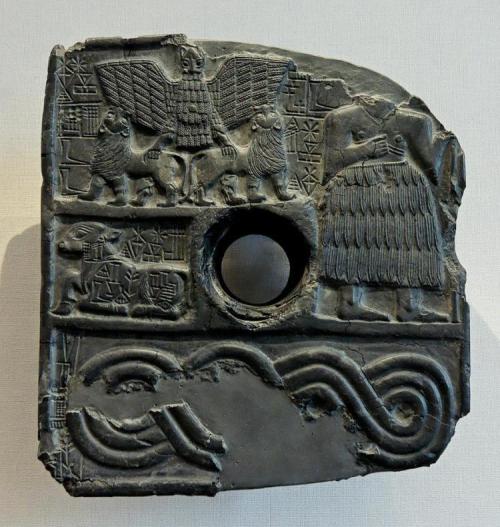Zu, Thunder God, and the Tablets of Destiny
“Zu was a storm-god symbolized in the form of a bird. He may typify the advancing storm-cloud, which would have seemed to those of old as if hovering like a great bird above the land which it was about to strike. The North-American Indians possess such a mythological conception in the Thunder-bird, and it is probable that the great bird called roc, so well known to readers of the Arabian Nights, was a similar monster—perhaps the descendant of the Zu-bird.

Zu or Anzu (from An ‘heaven’ and Zu ‘to know’ in Sumerian), as a lion-headed eagle, ca. 2550–2500 BCE, Louvre.
Votive relief of Ur-Nanshe, king of Lagash, representing the bird-god Anzu (or Im-dugud) as a lion-headed eagle.
Alabaster, Early Dynastic III (2550–2500 BCE). Found in Telloh, ancient city of Girsu. H. 21.6 cm (8 ½ in.), W. 15.1 cm (5 ¾ in.), D. 3.5 cm (1 ¼ in.)
http://bharatkalyan97.blogspot.com/2013/07/legend-of-anzu-which-stole-tablets-of.html
We remember how this enormous creature descended upon the ship in which Sindbad sailed and carried him off. Certain it is that we can trace the roc or rukh to the Persian simurgh, which is again referable to a more ancient Persian form, the amru or sinamru, the bird of immortality, and we may feel sure that what is found in ancient Persian lore has some foundation in Babylonian belief.
The Zu-bird was evidently under the control of the sun, and his attempt to break away from the solar authority is related in the following legend.
It is told of the god Zu that on one occasion ambition awaking in his breast caused him to cast envious eyes on the power and sovereignty of Bel, so that he determined to purloin the Tablets of Destiny, which were the tangible symbols of Bel’s greatness.
At this time, it may be recalled, the Tablets of Destiny had already an interesting history behind them. We are told in the creation legend how Apsu, the primeval, and Tiawath, chaos, the first parents of the gods, afterward conceived a hatred for their offspring, and how Tiawath, with her monster-brood of snakes and vipers, dragons and scorpion-men and raging hounds, made war on the hosts of heaven.
Her son Kingu she made captain of her hideous army—
To march before the forces, to lead the host,
To give the battle-signal, to advance to the attack,
To direct the battle, to control the fight.
To him she gave the Tablets of Destiny, laying them on his breast with the words:
“Thy command shall not be without avail, and the word of thy mouth shall be established.”
Through his possession of the divine tablets Kingu received the power of Anu, and was able to decree the fate of the gods.
After several deities had refused the honour of becoming champion of heaven, Merodach was chosen. He succeeded at length in slaying Tiawath and destroying her evil host; and having vanquished Kingu, her captain, he took from him the Tablets of Destiny, which he sealed and laid on his own breast. It was this Merodach, or Marduk, who afterward became identified with Bel.

The Zu Bird appears to dominate the top of this bas relief, while the head of the figure on the right is missing, common vandalism committed by grave robbers: defacing the heads and the eyes of idols crippled their efficacy.
Now Zu, in his greed for power and dominion, was eager to obtain the potent symbols. He beheld the honour and majesty of Bel, and from contemplation of these he turned to look upon the Tablets of Destiny, saying within himself :
“Lo, I will possess the tablets of the gods, and all things shall be subject unto me. The spirits of heaven shall bow before me, the oracles of the gods shall lie in my hands. I shall wear the crown, symbol of sovereignty, and the robe, symbol of godhead, and then shall I rule over all the hosts of heaven.”
Thus inflamed, he sought the entrance to Bel’s hall, where he awaited the dawn of day. The text goes on :
Now when Bel was pouring out the clear water, (i.e. the light of day?)
And his diadem was taken off and lay upon the throne,
(Zu) seized the Tablets of Destiny,
He took Bel’s dominion, the power of giving commands.
Then Zu fled away and hid himself in his mountain.
Bel was greatly enraged at the theft, and all the gods with him. Anu, lord of heaven, summoned about him his divine sons, and asked for a champion to recover the tablets. But though the god Ramman was chosen, and after him several other deities, they all refused to advance against Zu.
The end of the legend is unfortunately missing, but from a passage in another tale, the legend of Etana, we gather that it was the sun-god, Shamash, who eventually stormed the mountain-stronghold of Zu, and with his net succeeded in capturing the presumptuous deity.
This legend is of the Prometheus type, but whereas Prometheus (once a bird-god) steals fire from heaven for the behoof of mankind, Zu steals the Tablets of Destiny for his own. These must, of course, be regained if the sovereignty of heaven is duly to continue, and to make the tale circumstantial the sun-god is provided with a fowler’s net with which to capture the recalcitrant Zu-bird.
Jastrow believes the myth to have been manufactured for the purpose of showing how the tablets of power were originally lost by the older Bel and gained by Merodach, but he has discounted the reference in the Etana legend relating to their recovery.”
Lewis Spence, Myths and Legends of Babylonia and Assyria, 1917, pp. 193-5.

![Illustration: Shamash the Sun-god setting (?) on the horizon. In his right he holds a tree (?), and in his left a ... with a serrated edge. Above the horizon is a goddess who holds in her left hand an ear of corn. On the right is a god who seems to be setting free a bird from his right hand. Round him is a river with fish in it, and behind him is an attendant god; under his foot is a young bull. To the right of the goddess stand a hunting god, with a bow and lasso, and a lion. From the seal-cylinder of Adda ..., in the British Museum. About 2500 B.C. [No. 89,115.]](https://therealsamizdat.com/wp-content/uploads/2015/01/an00135126_001_l.jpg?w=500)
![Illustration: Shamash the Sun-god rising on the horizon, flames of fire ascending from his shoulder. The two portals of the dawn, each surmounted by a lion, are being drawn open by attendant gods. From a Babylonian seal cylinder in the British Museum. [No. 89,110.]](https://therealsamizdat.com/wp-content/uploads/2015/01/an00323246_001_l.jpg?w=500)
 .
. , Ilu Nagar Ilu Nagar, i.e., “the workmen gods,” about whom nothing is known.
, Ilu Nagar Ilu Nagar, i.e., “the workmen gods,” about whom nothing is known.